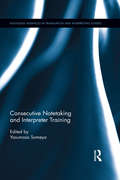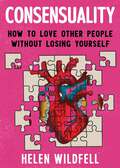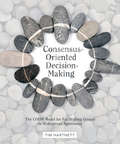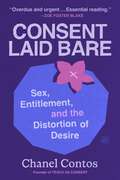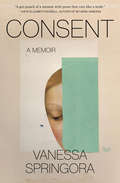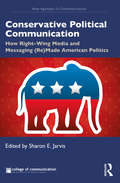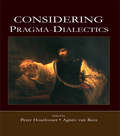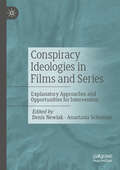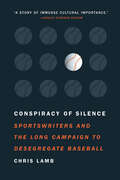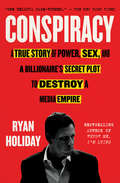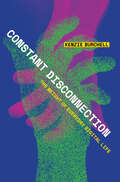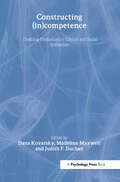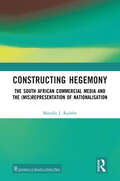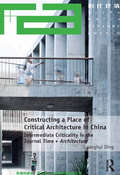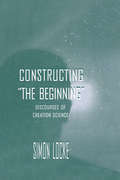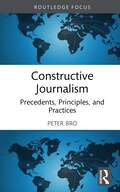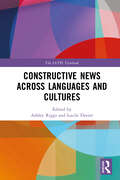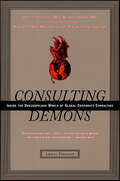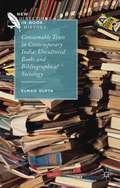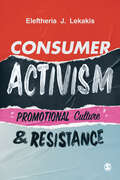- Table View
- List View
Consecutive Notetaking and Interpreter Training (Routledge Advances in Translation and Interpreting Studies)
by Yasumasa SomeyaThis book focuses on the theoretical foundation of notetaking (NT), an essential skill of consecutive interpreting. Explaining the "whys" pertaining to the cognitive, linguistic, and pedagogical issues surrounding NT, this book addresses this neglected aspect of notetaking discourse and brings together most updated and different, if not opposing, theoretical perspectives by leading researchers and practitioners from both the West and the East: France, Germany, Taiwan, and Japan. The book, although primarily focused on the theoretical aspects of consecutive notetaking, also covers other issues pertaining to interpreter training and pedagogy in general, and provides instructors with useful guidelines and empirically-tested pieces of advice for good pedagogical practices.
Consensuality: Navigating Feminism, Gender, and Boundaries Towards Loving Relationships
by Helen WildfellThere are infinite possibilities in human relationships, but the fairytale ideal of companionship does not exist for most people. In Consensuality, Helen Wildfell and her co-adventurers detail the process for creating or finding a healthy, successful relationship as well as common pitfalls and how to avoid them, like gender identity, sexual boundaries, power struggles, and emotional dysfunction. Overcoming regret and resentment, the authors describe a journey towards a respectful social environment. Their experiences lead to lessons of self-empowerment and communication tips for building healthy partnerships. We recognize their preferences and boundaries. We discuss how those fit with our own preferences and boundaries. Filled with personal descriptions of the complex layers in human interaction, the book combines gender studies with memoir to truly make the personal political.
Consensus-Oriented Decision-Making
by Tim HartnettConsensus-Oriented Decision-Making combines extensive knowledge of effective communication techniques with deep insight into conflict resolution and group dynamics. This practical step-by-step facilitation guide presents an efficient method any business, government, non-profit, social or community group can use to generate widespread agreement on important decisions with full member participation in an atmosphere of true collaboration.
Consent Laid Bare: Sex, Entitlement, and the Distortion of Desire
by Chanel ContosThe game-changing book about sex, consent, and the distortion of desire, a battle cry from a generation no longer prepared to stay silent.When activist and internationally renowned philanthropist, Chanel Contos asked her followers to share their stories of sexual assault, her post went viral. Almost 7,000 people provided testimonies of surviving sexual violence by people they knew, but virtually none of these incidents had been reported to authorities. The testimonies proved that sexual assault is widespread and Chanel was on a quest to understand why. In an era of growing inequality, Contos argues that when it comes to sex, we are all still working with an outdated social contract that privileges cisgender men's pleasure at the expense of humanity.In Consent Laid Bare, Chanel challenges the rampant inequality that reinforces violent behavior and questions whether consent is possible in a world where female sexuality has been hijacked. She offers girls and women the tools and encouragement to seek sex that is truly enjoyable which involves:Redefining consentChallenging gender normsLanguage's influence on rape discourseUnderstanding fawning responses Equipping teens to combat toxic masculinityChanel's message of fostering empathy is especially urgent in the face of rising rates of toxic messages about masculinity and manhood that are targeting our young men.
Consent: A Memoir
by Vanessa Springora“Consent” is a Molotov cocktail, flung at the face of the French establishment, a work of dazzling, highly controlled fury...By every conceivable metric, her book is a triumph.” -- The New York Times Already an international literary sensation, an intimate and powerful memoir of a young French teenage girl’s relationship with a famous, much older male writer—a universal #MeToo story of power, manipulation, trauma, recovery, and resiliency that exposes the hypocrisy of a culture that has allowed the sexual abuse of minors to occur unchecked.Sometimes, all it takes is a single voice to shatter the silence of complicity.Thirty years ago, Vanessa Springora was the teenage muse of one of the country’s most celebrated writers, a footnote in the narrative of a very influential man in the French literary world.At the end of 2019, as women around the world began to speak out, Vanessa, now in her forties and the director of one of France’s leading publishing houses, decided to reclaim her own story, offering her perspective of those events sharply known.Consent is the story of one precocious young girl’s stolen adolescence. Devastating in its honesty, Vanessa’s painstakingly memoir lays bare the cultural attitudes and circumstances that made it possible for a thirteen-year-old girl to become involved with a fifty-year-old man who happened to be a notable writer. As she recalls the events of her childhood and her seduction by one of her country’s most notable writers, Vanessa reflects on the ways in which this disturbing relationship changed and affected her as she grew older.Drawing parallels between children’s fairy tales and French history and her personal life, Vanessa offers an intimate and absorbing look at the meaning of love and consent and the toll of trauma and the power of healing in women’s lives. Ultimately, she offers a forceful indictment of a chauvinistic literary world that has for too long accepted and helped perpetuate gender inequality and the exploitation and sexual abuse of children. Translated from the French by Natasha Lehrer"...One of the belated truths that emerges from [Consent] is that Springora is a writer. [...]Her sentences gleam like metal; each chapter snaps shut with the clean brutality of a latch." -- The New Yorker"Consent [is] rapier-sharp, written with restraint, elegance and brevity." -- The Times (London)"[Consent] has something steely in its heart, and it departs from the typical American memoir of childhood abuse in exhilarating ways." -- Slate"Lucid and nuanced...[Consent] will speak to trauma survivors everywhere." -- Los Angeles Review of Books”A piercing memoir about the sexually abusive relationship she endured at age 14 with a 50-year-old writer...This chilling account will linger with readers long after the last page is turned.” -- Publishers Weekly "Springora's lucid account is a commanding discussion of sexual abuse and victimization, and a powerful act of reclamation." -- Booklist"A chilling story of child abuse and the sophisticated Parisians who looked the other way...[Springora] is an elegant and perceptive writer." -- Kirkus
Conservative Political Communication: How Right-Wing Media and Messaging (Re)Made American Politics (New Agendas in Communication Series)
by Sharon E. JarvisConservative Political Communication examines the evolution of appeals, media, and tactics in right-wing media and political communication, tracking trends and shifts from the early days of contemporary conservatism in the 1950s to the Trump administration. The chapters in this edited volume feature the work of senior and junior scholars from the fields of communication, journalism, and political science employing content analytic, experimental, survey, historical, and rhetorical research methodologies. Analyses of the rise of the 24-hour news cycle, the range of partisan news sources, and the role of social media algorithms in political campaigns yield insights for our media and information ecosystems. A key theme across these chapters is how right-wing channels and communications help and hinder partisan fragmentation, a condition whereby novice elected officials create personal conservative brands, appeal to the base through partisan media, and complicate senior leadership’s ability to engage in bargaining, compromise, and deal-making. This volume interrogates conservative media and messaging to track where these processes came from, how they functioned in the 2016 U.S. presidential campaign, and where they may be going in the future. This book will interest scholars and upper-level students of political communication, media and politics, and political science, as well as readers invested in today’s political media landscape in the United States.
Considering Pragma-Dialectics
by Peter Houtlosser Agnès Van ReesConsidering Pragma-Dialectics honors the monumental contributions of one of the foremost international figures in current argumentation scholarship: Frans van Eemeren. The volume presents the research efforts of his colleagues and addresses how their work relates to the pragma-dialectical theory of argumentation with which van Eemeren’s name is so intimately connected. This tribute serves to highlight the varied approaches to the study of argumentation and is destined to inspire researchers to advance scholarship in the field far into the future. Replete with contributions from highly-esteemed academics in argumentation study, chapters in this volume address such topics as:*Pragma-dialectic versus epistemic theories of arguing and arguments;*Pragma-dialectics and self-advocacy in physician-patient interactions;*The pragma-dialectical analysis of the ad hominem family;*Rhetoric, dialectic, and the functions of argument; and*The semantics of reasonableness. As an exceptional volume and a fitting tribute, this work will be of interest to all argumentation scholars considering the astute insights and scholarly legacy of Frans van Eemeren.
Consiga un trabajo hoy (How to Write a Resume and Get a Job)
by Luis CortesConsiga Un Trabajo Hoy Encontrar un empleo puede ser una tarea estresante. Hasta resulta difícil saber por dónde comenzar. ¿Dónde están las listas de empleos? ¿Qué destrezas se requieren? ¿Cómo puede hacer que su hoja de vida se destaque? La búsqueda de un empleo conlleva muchas reglas que usted no puede quebrantar, y es fácil que inadvertidamente usted reduzca sus oportunidades. En Consiga un trabajo hoy, el Rdo. Luis Cortés le brinda a usted la información necesaria para obtener un empleo prometedor. Este libro lo conduce paso a paso a través de todo el proceso, desde la búsqueda y la solicitud de empleo, hasta la negociación de un mejor salario y la petición de beneficios. Un empleo no lo es todo en la vida, pero sí la llave de un futuro mejor. Este libro le garantiza que su búsqueda será exitosa.
Conspiracy Ideologies in Films and Series: Explanatory Approaches and Opportunities for Intervention
by Denis Newiak Anastasia SchnitzerCorona as a staged instrument of oppression, secretly kept vaccination deaths or politicians drinking children's blood: at the latest since the outbreak of the Covid 19 pandemic, conspiracy ideologies are booming and harm social peace and democratic will formation through their dogmatism. So-called conspiracy theories generate systematic distrust of legitimate political institutions and can contribute to social polarization, dangerous populism and extremist escalation. Conspiracy ideologies have always been a topic in movies and television series, as they have always dealt with the relationship between reality and illusion, truth and fiction, reality and dream, sense and madness through their cinematic means. Series and films not only serve as a discursive space for social self-understanding, but also, through their complex narratives, constellations of characters and aesthetics, offer catchy explanations for the emergence and spread of conspiracy narratives. At the same time, theymake suggestions, some of them astonishingly concrete, for dealing with such collective delusions. What can we learn from the fictional worlds of series and films for dealing with this very real contemporary phenomenon?
Conspiracy of Silence: Sportswriters and the Long Campaign to Desegregate Baseball
by Chris LambThe campaign to desegregate baseball was one of the most important civil rights stories of the 1930s and 1940s. But most of white America knew nothing about this story because mainstream newspapers said little about the color line and still less about the efforts to end it. Even today, as far as most Americans know, the integration of baseball revolved around Branch Rickey&’s signing of Jackie Robinson to the Brooklyn Dodgers&’ organization in 1945. This book shows how Rickey&’s move, critical as it may have been, came after more than a decade of work by Black and left-leaning journalists to desegregate the game. Drawing on hundreds of newspaper articles and interviews with journalists, Chris Lamb reveals how differently Black and white newspapers, and Black and white America, viewed racial equality. Between 1933 and 1945, Black newspapers and the communist Daily Worker published hundreds of articles and editorials calling for an end to baseball&’s color line, while white mainstream sportswriters perpetuated the color line by participating in what their Black counterparts called a &“conspiracy of silence.&” The alternative presses&’ efforts to end baseball&’s color line, chronicled for the first time in Conspiracy of Silence, constitute one of the great untold stories of baseball—and the civil rights movement.
Conspiracy: Peter Thiel, Hulk Hogan, Gawker, and the Anatomy of Intrigue
by Ryan HolidayIn the tradition of Janet Malcolm's THE JOURNALIST AND THE MURDERER and Robert Greene's THE 48 LAWS OF POWER, author Ryan Holiday examines the case that rocked the media world--and the billionaire mastermind behind itIn 2007, a short blogpost on Valleywag, the Silicon Valley-vertical of Gawker Media, outed PayPal founder and billionaire investor Peter Thiel as gay. Thiel's sexuality had been known to close friends and family, but he didn't consider himself a public figure, and believed the information was private. This post would be the casus belli for a meticulously plotted conspiracy that would end nearly a decade later with a $140 million dollar judgment against Gawker, its bankruptcy and with Nick Denton, Gawker's CEO and founder, out of a job. Only later would the world learn that Gawker's demise was not incidental--it had been masterminded by Thiel.For years, Thiel had searched endlessly for a solution to what he'd come to call the "Gawker Problem." When an unmarked envelope delivered an illegally recorded sex tape of Hogan with his best friend's wife, Gawker had seen the chance for millions of pageviews and to say the things that others were afraid to say. Thiel saw their publication of the tape as the opportunity he was looking for. He would come to pit Hogan against Gawker in a multi-year proxy war through the Florida legal system, while Gawker remained confidently convinced they would prevail as they had over so many other lawsuit--until it was too late. The verdict would stun the world and so would Peter's ultimate unmasking as the man who had set it all in motion. Why had he done this? How had no one discovered it? What would this mean--for the First Amendment? For privacy? For culture?In Holiday's masterful telling of this nearly unbelievable conspiracy, informed by interviews with all the key players, this case transcends the narrative of how one billionaire took down a media empire or the current state of the free press. It's a study in power, strategy, and one of the most wildly ambitious--and successful--secret plots in recent memory.Some will cheer Gawker's destruction and others will lament it, but after reading these pages--and seeing the access the author was given--no one will deny that there is something ruthless and brilliant about Peter Thiel's shocking attempt to shake up the world.
Constant Disconnection: The Weight of Everyday Digital Life
by Kenzie BurchellThe weight of constant digital connection is the default condition of working life, home life, and everyday personal life – driving us to engage more with platforms than with people, a new state of constant disconnection that we cannot escape. Overflowing email inboxes, deluges of mobile phone notifications and torrents of social media posts—the flow of communication in its abundance is today's individualized interface for interpersonal and professional practices. Communication technologies and their use are both the needle and the thread of the wider social tapestry of everyday contemporary life. This ever-changing communication environment is where the neoliberal economic policies of the West and the commercial imperatives of the platform and data-mining industries meet. It is where the contradictions they produce can be felt day-to-day by citizens-turned-users. How does it feel to live at the pressure points of intersecting economic realities and why does it matter? Drawing on extensive sociological research, Burchell examines how individuals try to manage connection as participation in everyday life and how, on a larger scale, the ever-expanding knowledge, communication, and data-driven economies depend on the very pressures that result from our disparate communication needs. With so much time spent managing the pressures of our communication environment, we often overlook the way media technologies produce systemic tensions that are reshaping how we interact with each other and what we understand to be social connection today.
Constraints on Language Acquisition: Studies of Atypical Children
by Helen Tager-FlusbergAfter decades of research most scholars generally agree that language acquisition is a complex and multifaceted process that involves the interaction of innate biologically-based mechanisms devoted to language, other non-linguistic cognitive and social mechanisms, linguistic input, and information about the social and physical world. Theoretical work in the field of language acquisition now needs to focus in greater depth and detail on some specific aspects of this general model, which is the main goal of this book. The chapters in this volume provide some new insights into one of the most remarkable accomplishments achieved by almost all children. The particular questions that are raised by contributors include: * What kinds of constraints operate on the process of language development? * Which aspects of the acquisition process depend on language-specific mechanisms? * Are there critical brain structures necessary for the acquisition of language? * What role do cognitive and social mechanisms play in language development? * How critical is perceptual input about the physical and social world? * What is the specific role played by linguistic input in the child's construction of a linguistic system? Questions are addressed from the perspective of children who come to the task of acquiring language with many hurdles to overcome, including deafness and blindness, mental retardation, autism, and prenatal or perinatal brain damage involving the left hemisphere. Each section contributes some insight on how an innate language-specific biological substrate interacts with cognitive and social factors, as well as external information, to support the child's construction of a linguistic system. Studies of atypical children offer a singular contribution to this enterprise by allowing us to see the specific influences of each component, and in turn, they shed new light on how all children are able to acquire language so effortlessly and during such a brief period of development.
Constructing (in)competence: Disabling Evaluations in Clinical and Social interaction
by Judith Felson Duchan Dana Kovarsky Madeline MaxwellCompetence and incompetence are constructs that emerge in the social milieu of everyday life. Individuals are continually making and revising judgments about each other's abilities as they interact. The flexible, situated view of competence conveyed by the research of the authors in this volume is a departure from the way that competence is usually thought about in the fields of communication disabilities and education. In the social constructivist view, competence is not a fixed mass, residing within an individual, or a fixed judgment, defined externally. Rather, it is variable, sensitive to what is going on in the here and now, and coconstructed by those present. Constructions of competence are tied to evaluations implicit in the communication of the participants as well as to explicit evaluations of how things are going. The authors address the social construction of competence in a variety of situations: engaging in therapy for communication and other disorders, working and living with people with disabilities, speaking a second language, living with deafness, and giving and receiving instruction. Their studies focus on adults and children, including those with disabilities (aphasia, traumatic brain injury, augmentative systems users), as they go about managing their lives and identities. They examine the all-important context in which participants make competence judgments, assess the impact of implicit judgments and formal diagnoses, and look at the types of evaluations made during interaction. This book makes an argument all helping professionals need to hear: institutional, clinical, and social practices promoting judgments must be changed to practices that are more positive and empowering.
Constructing Hegemony: The South African Commercial Media and the (Mis)Representation of Nationalisation
by Mandla J. RadebePost-apartheid South Africa continues to face challenges in its attempts at economic transformation from decades of apartheid and colonisation. This need for revolution has resulted in various policy initiatives, including the ongoing demands for the nationalisation of the economy. The commercial media has a central role in shaping policy debates. But this media is an ideological tool and an economic resource since it is owned and controlled by people with political and economic interests and, therefore, tends to support and promote their interests. This book provides a Marxist critique of the representation of the nationalisation of the mines debate by the South African commercial media. Radebe examines corporate control of the media to articulate the interrelations between the State, Capital and the Media and how commercial media represents, shapes and influences public policy. He concludes that beyond factors such as ownership, commercialisation and the influence of advertising on news content, the global capitalist hegemony has a more powerful effect on the commercial media in South Africa than previously thought. Print edition not for sale in Sub Saharan Africa.
Constructing a Place of Critical Architecture in China: Intermediate Criticality in the Journal Time + Architecture
by Guanghui DingFor the past 30 years, The Chinese journal Time + Architecture (Shidai Jianzhu) has focused on publishing innovative and exploratory work by emerging architects based in private design firms who were committed to new material, theoretical and pedagogical practices. In doing so, this book argues that the journal has engaged in the presentation and production of a particular form of critical architecture - described as an ’intermediate criticality’ - as a response to the particular constraints of the Chinese cultural and political context. The journal’s publications displayed a ’dual critique’ - a resistant attitude to the dominant modes of commercial building practice, characterised by rapid and large-scale urban expansion, and an alternative publishing practice focusing on emerging, independent architectural practitioners through the active integration of theoretical debates, architectural projects, and criticisms. This dual critique is illustrated through a careful review and analysis of the history and programme of the journal. By showing how the work of emerging architects, including Yung Ho Chang, Wang Shu, Liu Jiakun and Urbanus, are situated within the context of the journal’s special thematic editions on experimental architecture, exhibition, group design, new urban space and professional system, the book assesses the contribution the journal has made to the emergence of a critical architecture in China, in the context of how it was articulated, debated, presented and perhaps even ’produced’ within the pages of the publication itself. The protagonists of critical architecture have endeavoured to construct an alternative mode of form and space with strong aesthetic and socio-political implications to the predominant production of architecture under the current Chinese socialist market economy. To rebel against certain forms of domination and suppression by capital and power is by no means to completely reject them; rather, it is to use thos
Constructing the Beginning: Discourses of Creation Science (Routledge Communication Series)
by Simon LockeIn Constructing the Beginning, Simon Locke offers a new approach to considering the enigma of creation science, using the perspective of discourse analysis. Using the publications of the British Creation Science Movement to perform a detailed analysis of the creationist case, Locke demonstrates that the discourses and rhetorics used by natural and social scientists are also employed by non-scientists. Out of this study, a view of science as a cultural resource develops, questioning the adequacy of perceived sociological wisdom that sees science as the source and emmbodiment of cultural "rationalization." As a case study of the use of science as a discursive resource in everyday life, Constructing the Beginning speaks to scholars of discourse analysis, constructionism, rhetorics, and the public understanding of science. It will also be of great interest to scholars in the areas of cultural studies, sociology of scientific knowledge and of religion, postmodernism, and sociological theory. Additional Copy Creation science is the target of much attack these days from both within and outside of the orthodox scientific community. This book, however, takes a different approach. It is not an attack on creationism; nor is it a defense. The author's interest is not in creationism at all, but rather, it is in the questions of the role and significance of science in modernity or the public understanding of science. Locke's approach to this issue is a discursive and rhetorical one. Creationism is treated as a case study of the argumentative engagement between science and non-science which--in his view--is as central to the commonsense lifeworld of modernity as much as it is to the lives of its intellectuals. An important dimension of the public meaning of science in modernity is its limits and its relations with other modes of thought and belief, which continue to survive as discourses in the wider culture. Creationism is merely one example of this general feature. The book begins with a discussion of the current issues in the public understanding of science in relation to traditional sociological views of the impact of science on modernity. This is examined through rationalization and the contrasting view derived from the sociology of scientific knowledge which points to the likelihood of a much more complex and variable relationship than rationalization proposes. It continues with an argument and detailed analysis that focuses on three main points: *the problem of a competing account of reality (the world), in the form of evolution; *the problem of competing accounts of the Bible (the Word), in the form of different versions of Christianity; and *the realization that both of these problems must be managed together in such a way that creationists' own version(s) of the world and of the Word are compatible--a compatibility achieved through a discursive syncretism. The final chapter brings together the strands of the argument to further develop the implications of the dilemma of science for the public understanding of science through the idea of science as a cultural resource and its possible relation to other such cultural resources within modernity--such as Christianity. It is suggested that much so-called "anti-science" could be made sense of in these terms and proposes further research in this direction.
Construction and Analysis of Cryptographic Functions
by Lilya BudaghyanThis book covers novel research on construction and analysis of optimal cryptographic functions such as almost perfect nonlinear (APN), almost bent (AB), planar and bent functions. These functions have optimal resistance to linear and/or differential attacks, which are the two most powerful attacks on symmetric cryptosystems. Besides cryptographic applications, these functions are significant in many branches of mathematics and information theory including coding theory, combinatorics, commutative algebra, finite geometry, sequence design and quantum information theory. The author analyzes equivalence relations for these functions and develops several new methods for construction of their infinite families. In addition, the book offers solutions to two longstanding open problems, including the problem on characterization of APN and AB functions via Boolean, and the problem on the relation between two classes of bent functions.
Constructional and Cognitive Explorations of Contrastive Linguistics
by Annalisa Baicchi Cristiano BrocciasThis book approaches the field of contrastive linguistics from a comparative and robust perspective that combines the tenets of construction grammar and cognitive linguistics. In doing so, it shows how their integration can help to successfully enhance research on contrastivity, by means of updated theoretical frameworks and applied methodologies that combine language and thought. It compares ten different languages and offers analyses of constructions at all levels of the linguistic organization, identifying the cognitive motivations that instantiate the linguistic data retrieved from corpora. Relevant to both cognitive and non-cognitive linguists interested in variation and contrastive approaches, as well as graduate students in these areas, this book makes a significant contribution to existing work on the various types of constructional and discourse-based phenomena in modern languages.
Constructive Journalism: Precedents, Principles, and Practices (Routledge Focus on Journalism Studies)
by Peter BroThis book offers a deep and comprehensive overview of constructive journalism, setting out the guiding principles and practices for a journalism that aims to do more than simply inform about problems. In this authoritative yet concise volume, Peter Bro asks what does constructive journalism mean, what are the underlying principles, how is it practiced, and in what ways does it differ from other types of journalism? Drawing on studies of the rapidly growing number of works by both journalism practitioners and researchers, the book reaches beyond these questions to show how the notion of being constructive has been a part of journalism from the very beginning of the profession. This introduction to what constructive journalism is and was and what it can accomplish will guide new journalists; journalism, media, and mass communication students; and scholars working on journalistic theory and practice.
Constructive News Across Languages and Cultures (The IATIS Yearbook)
by Lucile Davier Ashley RiggsConstructive news is an alternative to the negativity of if-it-bleeds-it-leads journalism but still unfamiliar to some audiences and still relatively under-researched, particularly by news translation scholars. And yet, it is “done” across cultures and, therefore, languages. This innovative book contributes to filling that research gap and raising awareness of the phenomenon by showcasing cross-cultural research on constructive news, including in the Global South – a region that has traditionally received less scholarly attention than the Global North. Constructive news is resolutely multimodal, and so a number of chapters analyse it from that perspective. The chapters also tackle such topics as audience attitudes, service to the local community, pedagogy, financial news, and religious news. This book will appeal to journalism studies and translation scholars, applied linguists, lecturers, journalists, editors, and members of the public who consume, study, or teach news but are looking for alternatives.
Consulting Demons: Inside the Unscrupulous World of Global Corporate Consulting
by Lewis PinaultIn this gripping and colorful account of the American dream gone astray, Lewis Pinault provides the essential guidelines on how to get ahead and an enlightening perspective on the brutal infighting that can engulf even the most civilized consulting firm. This stunning exposé of some of the most prestigious and respected names in the business leads you into a world where a client's interests are skillfully subordinated to those of the consultants, where money rules the day, and where principles and morals are unwelcome baggage.Humorous and insightful, this no-holds-barred account takes you behind the scenes of the dehumanizing indoctrination of an academic intellectual into an exploitative -- and exploited -- "global transformation contractor." Featuring new material dealing with the e-consulting industry's boom, bust, and its future, Consulting Demons offers the most complete look at an industry that exacts the highest prices for the most questionable standards of success.
Consumable Texts in Contemporary India
by Suman GuptaThrough what he terms "bibliographical sociology," Suman Gupta explores the presence of English-language publications in the contemporary Indian context their productions, circulations and readerships to understand current social trends. "
Consumer Activism: Promotional Culture and Resistance
by Eleftheria J Lekakis"A crucial intervention to both critical studies of consumption and research into activism. It authoritatively explores the complex and multiplying links between branding and neoliberal culture, consumer practices and social justice." – Professor Mehita Iqani, Stellenbosch University "Eleftheria Lekakis reminds us that as consumers, we can do much more than just buy our way out of social or political problems." – Professor Melissa Aronczyk, Rutgers University Consumption and resistance are entwined. From buying fair-trade, to celebrity advocates for social causes, to subvertising and anti-consumerist grassroots movements, consumer activism is now a key part of our fight for social and environmental justice. This book is a comprehensive exploration of the complexities and dilemmas of using the marketplace as an arena for politics. It goes beyond simply buying or boycotting to critically explore how individuals, collectives, corporations and governments do politics with and through consumption. Impassioned and always accessible, Eleftheria Lekakis explores: The media and economic logics which privilege elite activists. The real opportunities to resist and redirect promotional culture. Consumer activism as collective and community-building. The politicisation of celebrity influencers. The centrality of digital media technology. A range of transnational case studies pushing the field beyond the Global North. Consumer Activism: Promotional Culture and Resistance covers the full breadth of theory and practice you need to know. It is an essential resource for understanding, researching and engaging with the global phenomenon of consumer activism. Dr Eleftheria Lekakis is senior lecturer in Media and Communications at the School of Media, Arts, and Humanities at the University of Sussex.
Consumer Activism: Promotional Culture and Resistance
by Eleftheria J Lekakis"A crucial intervention to both critical studies of consumption and research into activism. It authoritatively explores the complex and multiplying links between branding and neoliberal culture, consumer practices and social justice." – Professor Mehita Iqani, Stellenbosch University "Eleftheria Lekakis reminds us that as consumers, we can do much more than just buy our way out of social or political problems." – Professor Melissa Aronczyk, Rutgers University Consumption and resistance are entwined. From buying fair-trade, to celebrity advocates for social causes, to subvertising and anti-consumerist grassroots movements, consumer activism is now a key part of our fight for social and environmental justice. This book is a comprehensive exploration of the complexities and dilemmas of using the marketplace as an arena for politics. It goes beyond simply buying or boycotting to critically explore how individuals, collectives, corporations and governments do politics with and through consumption. Impassioned and always accessible, Eleftheria Lekakis explores: The media and economic logics which privilege elite activists. The real opportunities to resist and redirect promotional culture. Consumer activism as collective and community-building. The politicisation of celebrity influencers. The centrality of digital media technology. A range of transnational case studies pushing the field beyond the Global North. Consumer Activism: Promotional Culture and Resistance covers the full breadth of theory and practice you need to know. It is an essential resource for understanding, researching and engaging with the global phenomenon of consumer activism. Dr Eleftheria Lekakis is senior lecturer in Media and Communications at the School of Media, Arts, and Humanities at the University of Sussex.
